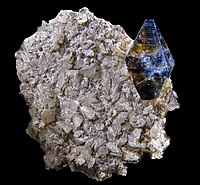
Photo from wikipedia
Abstract In this paper, the interactions between a H2O2 molecule and anatase TiO2(101) (A-TiO2) surface are studied by first-principle calculations. It is found that a H2O2 molecular can adsorb or… Click to show full abstract
Abstract In this paper, the interactions between a H2O2 molecule and anatase TiO2(101) (A-TiO2) surface are studied by first-principle calculations. It is found that a H2O2 molecular can adsorb or dissociate on A-TiO2(101) surface, in agreement with previous results. When a H2O2 molecule dissociates, Ti-μ-peroxide configurations may form. It should be noticed that a more stable Ti-μ-peroxide configuration is found in this paper. More interestingly, an oxygen atom of this dissociated H2O2 can enter into A-TiO2(101) lattice, i.e., forming surface (O2)o. The energy barriers for formations of new Ti-μ-peroxide and surface (O2)o species are 0.30 and 1.28 eV, respectively, which explain previous experimental results that the formations of Ti-μ-peroxide and (O2)o species are under lower and higher temperatures, respectively. The localized gap state of Ti-μ-peroxide disappears after the formation of surface (O2)o, and thus the recombination probability of electron-hole pairs should be reduced for the O-rich A-TiO2. These results can rationalize experimental results that the photocatalytic activity of A-TiO2 sample can be changed by H2O2 treating under different temperature.
Journal Title: Applied Surface Science
Year Published: 2019
Link to full text (if available)
Share on Social Media: Sign Up to like & get
recommendations!